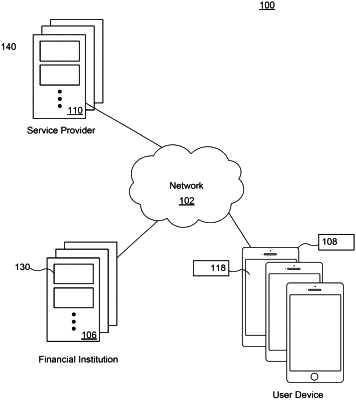| CPC G06Q 20/108 (2013.01) [G06N 20/00 (2019.01); G06Q 20/3221 (2013.01); G06Q 20/3223 (2013.01); G06Q 20/4037 (2013.01); G06Q 20/405 (2013.01); G06Q 30/0283 (2013.01); G06Q 40/02 (2013.01); G06Q 20/023 (2013.01); G06Q 30/0185 (2013.01); G06Q 50/01 (2013.01)] | 20 Claims |

|
1. A system for generating synthetic data, comprising:
a memory storing instructions; and
at least one processor configured to execute the instructions to perform operations comprising:
associate, via the at least one processor, a user with a first account at an institution;
associate, with the first account, a mobile device unique identifier for a mobile device associated with the user;
associate an account status with a first mode or a second mode based on a transaction tendency of the first account associated with a future time period;
wherein the processor permits the user to navigate only within a second graphical user interface associated with the second mode for performing a limited set of electronic operations associated with a set of electronic balance controls and one or more option controls for managing the first account while the first account is in the second mode;
store, via the at least one processor, data associated with the first account and the user in a database;
apply a predictive algorithm to the data to generate the transaction tendency;
predict using the transaction tendency, at least one account balance prediction;
responsive to determining that the first account will be in the second mode within the future time period based on the at least one account balance prediction:
transmitting a notification from a server to the mobile device associated with the user; and
disabling and replacing, on the mobile device, a first graphical user interface associated with the first mode with the second graphical user interface including the one or more option controls, wherein the one or more option controls include:
a first option to transfer funds from a second account to the first account; and
a second option to deposit funds into the first account;
generating an updated data set based on a user selected option control from the one or more option controls;
provide for display, on the application of the mobile device, a third graphical user interface comprising a plurality of setup graphical user interfaces corresponding to a plurality of micro-applications, including: a first setup interface for receiving a setting for associating the second account to the first account; and a second setup interface for receiving a user scope of access, wherein the second setup interface includes an interactive authorization control that allows the user to select the user scope of access;
determine whether the setting for associating the second account to the first account has been received;
responsive to determining the setting for associating the second account to the account has been received: receive an institution scope of access from the institution and the user scope of access from the user; and determine, based on the user scope of access and the institution scope of access, field-level data from the updated data set, wherein the field-level data comprises transaction data deemed sensitive by the user and data from the first account deemed sensitive by the user;
apply a machine learning algorithm to protect the field-level data by generating synthetic field-level data; and substitute the synthetic field-level data in place of the field-level data associated with the first account in at least one of an Automated Clearing House transaction or a mobile network transfer between the first account and the second account, wherein the processor permits a second user associated with the second account access only to the synthetic field-level data.
|
|
2. The system of claim 1, wherein the field-level data associated with the account is encrypted by the institution.
|
|
3. The system of claim 1, wherein the field-level data associated with the account is tokenized by the institution.
|
|
4. The system of claim 1, wherein the field-level data associated with the account is masked by the institution.
|
|
5. The system of claim 1, wherein the processor permits, based on the user scope of access, secure publication of the field-level data by the institution to a third-party service provider.
|